“Work is hard, distractions are plentiful, and time is short”, wrote Author Adam Hochschild.
In today’s world, there is so much pulling us in every direction, making it hard to focus. Other obligations, entertainment, and interruptions of all kinds can grab our attention away from our intended task. With too many things to think about, it can be easy to lose track of what you’re really trying to accomplish.
Without clear goals, your mind may be tempted to wander all over the place. When that happens, it becomes easy to misstep into a pitfall. If you don’t have your eyes on your goal, then every distraction along the way can trip you up.
So how do you avoid those focus stealing traps? Here’s a few pointers that may help to keep you focused on the goal and aware of those things that can pull you off course.
Digital Distractions
Most people today can’t even remember what it was like without digital devices. Just thinking about losing our phones can cause anxiety and panic. So it’s not surprising that they are difficult to set aside when trying to get other work done.
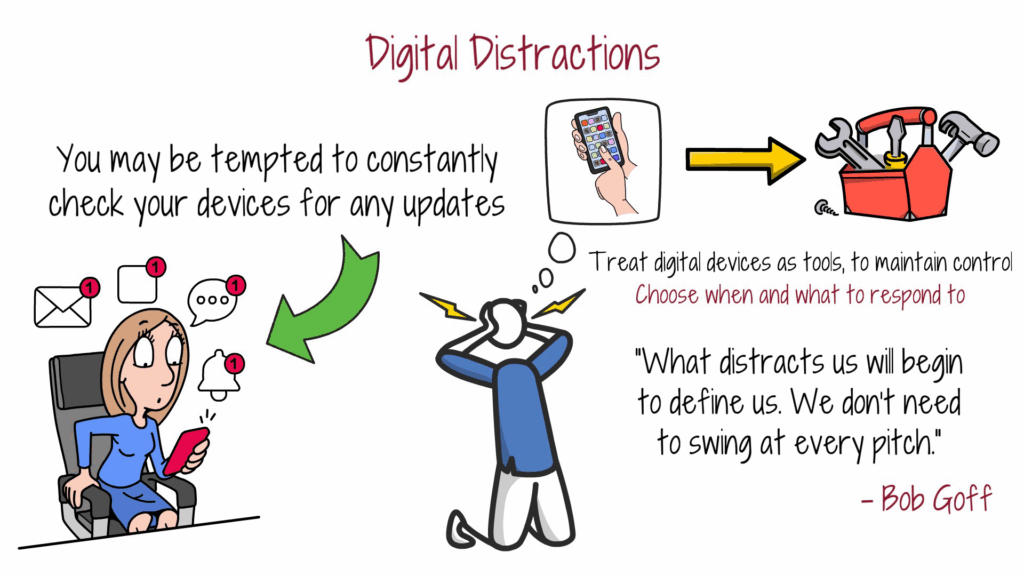
Social media can be addicting. Notifications can feel so urgent that we may find it stressful to be unavailable to respond. Emails may seem like they need an immediate reply. And just to be sure we haven’t missed anything, we may be tempted to constantly check our devices for any updates that might pop up.
But treating digital devices as tools, rather than attachments to our existence, is necessary to maintain control. If you are a slave to every distraction that comes up, you’ve lost the battle.
Author and speaker, Bob Goff, reminds us,
“What distracts us will begin to define us. We don’t need to swing at every pitch.”
By choosing when and what you want to respond to, you put yourself in the driver’s seat. You get to decide where you put your focus and when.
Multitasking
Another focus stealing trap is trying to do multiple things at once. When you split your attention in too many ways, your focus becomes fragmented and your ability to give 100% to anything is diminished. Once you’ve switched gears to do something else, it can take over 20 minutes to refocus again after an interruption.
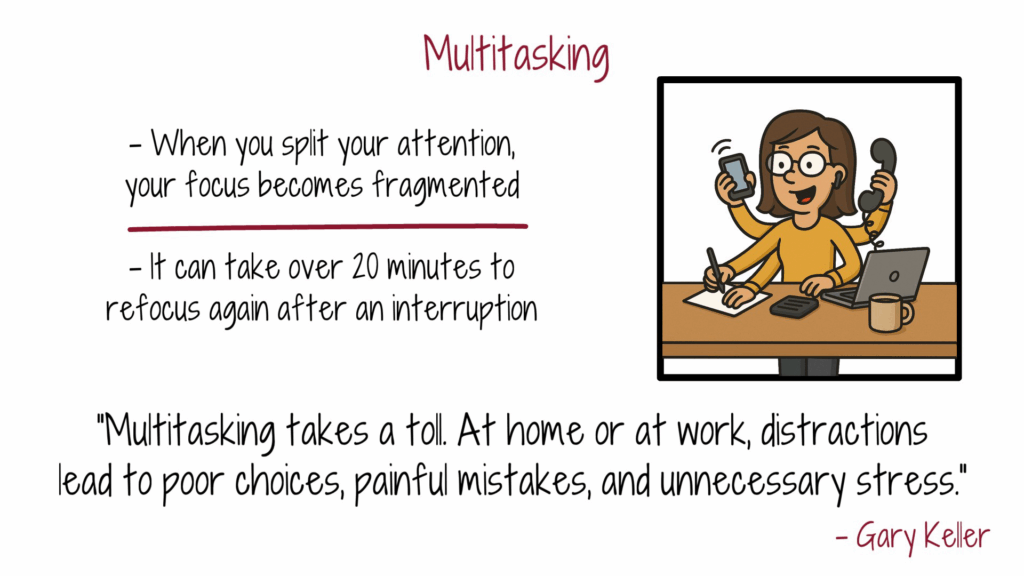
Real Estate Entrepreneur, Gary Keller, said,
“Multitasking takes a toll. At home or at work, distractions lead to poor choices, painful mistakes, and unnecessary stress.”
When you are continually switching from one task to another, productivity can actually decrease.
Environmental Distractions
The space you are working in can become another focus stealing trap. Noise, clutter, interruptions, and distractions in the surrounding area are all potential attention grabbers.
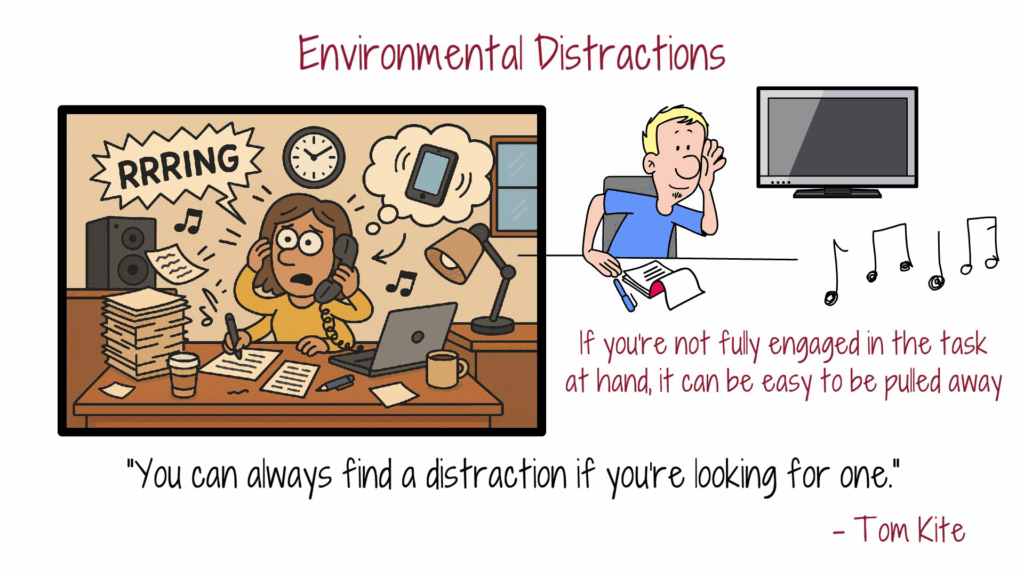
Pro golfer, Tom Kite, stated,
“You can always find a distraction if you’re looking for one.”
If you allow your mind to wander to outside noises, like a television or music playing close by, or the sound of people talking, you might be tempted to go see what it’s all about. If you’re not fully engaged in the task at hand, it can be easy to be pulled away by what’s happening around you.
Strategies to Avoid Distractions
So how can you avoid distractions and stay focused in a busy and sometimes noisy world when there is so much to do?
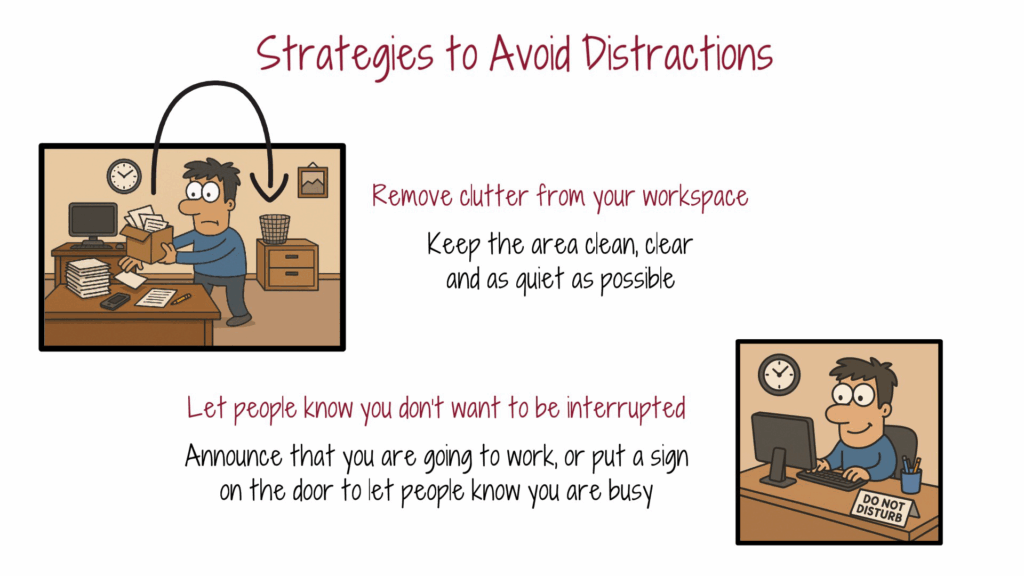
Start with your immediate surroundings:
- Remove clutter and other projects from your workspace. Keep the area clean and clear and as quiet as possible. Your brain can be easily enticed with other temptations if they are readily in view.
- Let people know you’re working and don’t want to be interrupted. Announce that you are going into your office to work, or put a sign on the door that will let people know you are busy. It may be helpful to let them know when you will be available again.
- Turn off notifications and silence unnecessary alerts on your devices.
- Use Focus Mode/Do not Disturb on your phone. Or you can remove it from your sight altogether by placing it in a drawer or another room.
Avoid Multitasking:
- Have one clear goal and purpose.
- Stay in the right mindset to focus on just one task. Regular meditation may help you to learn to focus your mind with ease and clarity. Your brain typically wants to grab at any shiny object that enters into it, like a monkey jumping from one tree to another. But you can train your brain to calm down and focus on one thing at a time.
Techniques to Stay Focused
Creating strategies to stay focused is one step. Combining those strategies with real techniques can be the key to avoiding those focus stealing traps.
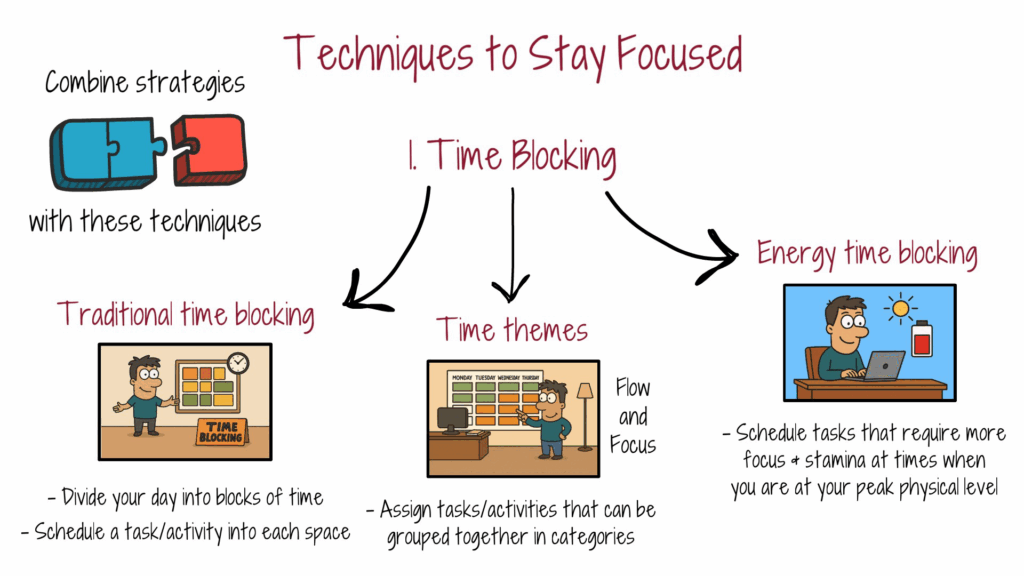
For instance, time blocking is one technique that can help you feel more organized and focused. To start, determine which type of time blocking works best for you.
- Traditional time blocking is an easy process of dividing your day into blocks of time. Then schedule a specific task or activity into each designated space. This is the basic idea of time blocking. It allows you to form a mindful plan for focused blocks of time.
- Time themes are another way to organize your time blocks. Assign tasks or activities that can be grouped together in categories. For example, you might schedule creative activities in succession. Or designate afternoons for office work. By keeping similar activities in continual time blocks, you can create flow and focus on a particular subject.
- Energy time blocking helps you to plan your blocks of time around your most productive energy levels. Schedule tasks that require more focus and stamina at times when you are at your peak physical level. Do less intense work at times when you are typically at a lower level of alertness. Make note of when you lose attention, and work this into a planned timing schedule, so you can work when you are at optimal energy levels.
Once you know what type of schedule you want to create, the next step is to complete the plan.
- Consider what tasks or activities you want to put on your schedule.
- Fill in your time boxes with appropriate tasks.
- Remember to leave some open spaces to accommodate unexpected or last minute additions that may pop up throughout the day.
The Pomodoro technique is another well known method that supports specific tasks being performed for a specific amount of time. Developed in the 1980’s by Francesco Cirillo, the Pomodoro technique involves working for short focused bursts with breaks in between.
- Choose a task or activity that you want to focus on.
- Minimize any distractions in advance.
- Set a timer for 25 minutes.
- Work on that task or activity, and nothing else for that amount of time.
- After 25 minutes, take a 5 minute break.
- Repeat the cycle 3 more times.
- Then take a longer break of 30 minutes.
If you need more time to complete the task, you can start the cycle again. Research has shown that the Pomodoro technique can help reduce internal and external distractions, promoting better focus and flow.
Single-tasking is one other method to consider when planning your daily schedule of tasks and activities. Focusing on one task at a time instead of multitasking can help you focus on all the parts of a specific task, doing thorough and better quality work. Giving something 100% of your attention may help you complete the job with better efficiency and accuracy.
Working on one thing until it’s done can promote feelings of accomplishment as you cross finished projects off your “to-do” list.
Final Thoughts
Some days can feel like you’re walking through a field of booby traps designed to undermine your best efforts, but knowing where you’re going, and what to watch out for, can help you navigate the danger zones and stay on track with clear focus.
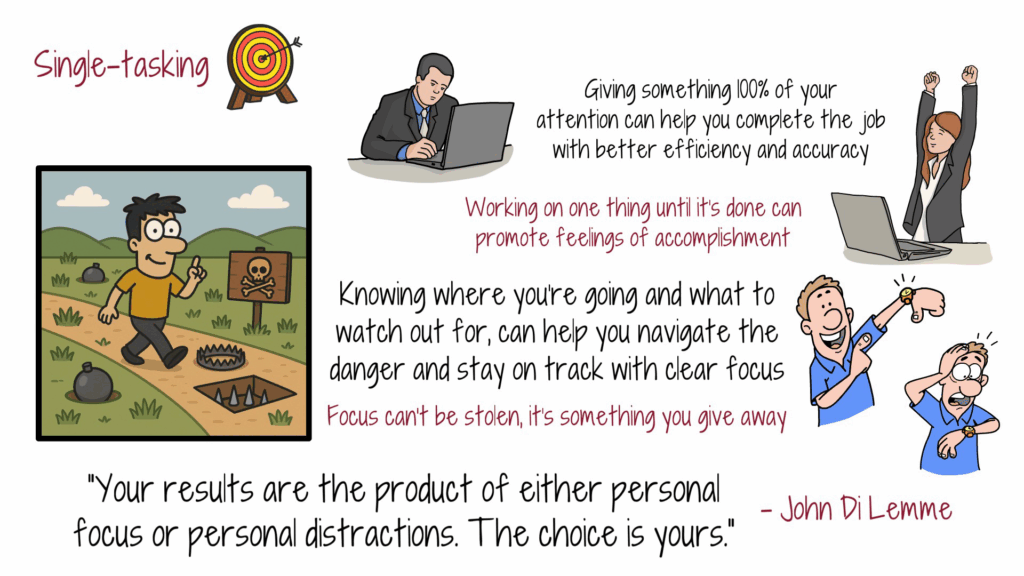
Another way to look at it is not to look at focus as something that can be stolen, but rather it’s something you give away. You control where you commit your attention. It’s up to you. Feed your focus and starve your distractions.
Author John Di Lemme wrote,
“Your results are the product of either personal focus or personal distractions. The choice is yours.”
By avoiding focus stealing traps, you can take control of your time, rather than allowing distractions to take control of you.
